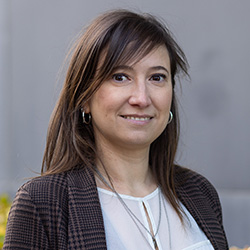Lifelong learning course highlighted as good example

Stefania Giacomello's course “Single cell and spatial transcriptomics data analysis” is digital, short and focused on a specific topic.
It was highlighted at the last Faculty Board meeting as a good example of how a lifelong learning course can be designed.
For a couple of years now, KTH has offered a number of courses in lifelong learning, i.e. free courses that are also available to people outside the university, both students and professionals.

At CBH's latest faculty board meeting, Per Berglund, who is responsible for Lifelong Learning at the school, gave a presentation. He highlighted a course given by Stefania Giacomello as a successful example of how a lifelong learning course can be designed in a sustainable and resource-efficient way.
Short and focused
“He said that having a course that is short, focused on specific topics and held online is a good option for KTH because it does not require additional classrooms. I think they are looking for these types of LL courses in general” says Stefania Giacomello, a researcher at the Department of Gene Technology.
The 2.5-credit course, which Stefania Giacomello has held it twice in the last two years, focuses on both the theoretical and data analysis aspects of new molecular technologies like single-cell RNA sequencing and spatial transcriptomic analysis (which was developed at KTH/SciLifeLab).
Everything is done online
“We do everything online. It is a digital course on Zoom with six to seven lectures and three computer labs to learn data analysis workflows. The labs are set up in a cloud service that the students can access. They program in the R language and we think the solution is very practical.” she says.
Teachers who want to teach a lifelong learning course can either start up a completely new course or use an existing course that they already teach. Stefania Giacomello chose the latter option and broke out 2.5 credits from a 7.5-credit course she teaches with colleague Afshin Ahmadian.
"A smooth transition"
“It is good from a teacher's perspective because the course already exists, so it is not difficult to start it up. It can be a smooth transition to also run a lifelong learning course. The main burden of opening up an existing course to outsiders is that it results in more students which requires more teacher assistants in the computer labs. This is more to flag a potential problem. If you open up to 150 extra students, it means quite a lot of extra work for teacher assistants and we need to find solutions for that,” she says.
Stefania Giacomello's course is in period 2 and attracts students from the biotechnology program, as well as other master's students, PhD students and postdocs within and outside KTH and professionals.
“Most often, the students are satisfied. A master's student who took my course then did the thesis in my research group and this student was from Uppsala University. So it's also an opportunity to identify highly motivated master's students and recruit outside KTH, at a national level,” Giacomello says.
Text: Sabina Fabrizi
